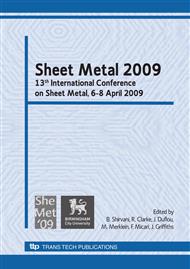p.43
p.53
p.61
p.69
p.79
p.87
p.97
p.105
p.117
Aluminium Alloy Self-Pierce Riveting for Joining of Aluminium Alloy Sheets
Abstract:
To simplify the recycling of automobiles, aluminium alloy sheets were joined by means of a self-piercing rivet. Although steel rivets used in conventional self-pierce riveting are removed from the aluminium alloy sheets in recycling, the removal is not required for aluminium alloy rivets. The joined sheets with the rivets are directly melted due to the same material, aluminium. For the joining of aluminium alloy sheet by the aluminium rivets, the joinability was improved by the designed shape of the rivet and die. To pierce the upper sheet, the diameter and edge angle of the rivet are modified. The diameter of the depth and the cavity of the die were also designed from trial and error using finite element simulation. The effectiveness of the designed rivet and die were evaluated from an experiment on riveting. The aluminium alloy sheets were joined by the optimised aluminium alloy self-piercing rivet and their effectiveness measured.
Info:
Periodical:
Pages:
79-86
Citation:
Online since:
March 2009
Authors:
Price:
Сopyright:
© 2009 Trans Tech Publications Ltd. All Rights Reserved
Share:
Citation:


